Tear Trough Fillers
Tear trough fillers are a non-invasive cosmetic treatment option for rejuvenation of the under-eye area. A tear trough is a crease in the under-eye area that might look sunken in or hollow, causing a tired, worn-out look and often worsening over time with age. Tear trough filler injections are placed between the lower eyelid and upper cheek to replenish volume and smooth out the under-eye hollows that can cast a shadow and result in the appearance of dark circles. If you’re looking for a solution for tired-looking under-eyes that doesn’t involve plastic surgery, Dr. Green is here to help. At her private dermatology office in Manhattan’s Upper East Side neighborhood, Dr. Green offers a host of non-invasive cosmetic procedures for rejuvenation, including under-eye fillers, Botox, laser treatments, microneedling, other various dermal fillers, chemical peels, and more.
The best types of filler for the under-eye area are hyaluronic acid fillers, such as Juvederm, Restylane, or Belotero. Patients appreciate the fact that as a non-surgical treatment option, tear trough fillers provide natural-looking, long-lasting rejuvenation results with zero downtime and few potential side effects. To guarantee safety, efficacy, and optimal results, dermal fillers should always be performed by an experienced medical professional, such as board-certified dermatologist Dr. Michele Green in NYC. Dr. Green is an expert injector who can work with you to ensure that you are a good candidate for tear trough fillers and develop a customized treatment plan that caters to your unique skin care concerns and aesthetic goals so that you look and feel like the best version of yourself.
Dr. Michele Green is a world-renowned expert in the field of cosmetic dermatology, with over 25 years spent treating the most discerning patients from around the globe for a myriad of skin concerns, such as dark under-eyes, sun damage, fine lines and wrinkles, hyperpigmentation, acne, and acne scars. She is consistently rated as a top NYC dermatologist by Castle Connolly, Super Doctors, New York Magazine, and The New York Times due to her expertise and dedication to her patients. When you work with Dr. Green to treat your under-eye area, you can trust that you have a provider with the skill and knowledge to provide you with the most phenomenal, natural-looking, long-lasting cosmetic results. During your consultation, Dr. Green will assess your under-eye hollows to choose the right teat trough filler for you that will leave you with a rejuvenated, youthful-looking under-eye area.
What are tear troughs?
A tear trough is an anatomic area of the face, the hollow located between the upper cheek and the lower eyelid region. Tear troughs can cast a shadow and create the appearance of a darkened under-eye area, making one look tired or prematurely aged. Tear troughs can be genetic, but they may also present due to the natural loss of collagen that occurs as we age. Reduced collagen levels in the under-eye area lead to transparent, thin skin, increasing the visibility of underlying blood vessels and creating a darkened under-eye area.
What does tear-trough filler do?
Tear trough fillers restore lost volume in the crease below the eye and improve the appearance of dark circles and under-eye bags. Tear trough fillers, with various hyaluronic dermal fillers, such as Belotero, Restylane, and Juvederm, will help correct this tear trough deformity. Dermal fillers are designed to restore collagen production and replenish lost volume in the treatment area. When injected into the tear trough area, dermal fillers work to reduce the appearance of dark circles and shadowing under the eyes. The preferred dermal fillers for this treatment area are composed of hyaluronic acid gel and have a small particle size. Hyaluronic acid is a component that is naturally produced by the body and helps plump the skin and increase collagen production, resulting in a more youthful-looking complexion. Using dermal fillers to treat the under-eye area can deliver natural-looking volume restoration and reduce the appearance of fine lines, puffiness, and dark circles.
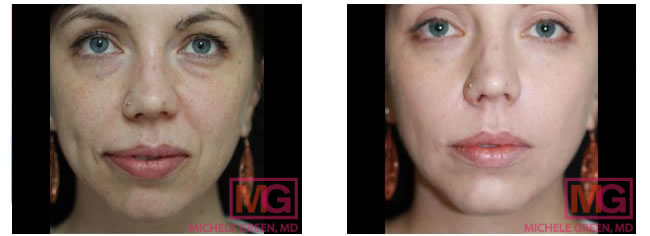
Before and after 1 syringe of Restylane in Tear Troughs (under eyes)
What is the best filler for tear troughs?
Dr. Green often uses hyaluronic acid fillers such as Juvederm Volbella, Restylane, Restylane Eyelight, and Belotero Balance. Hyaluronic acid (HA) is a substance that occurs naturally in the body, and HA fillers work to restore lost volume and hydration in the tear troughs to correct tired-looking eyes and under-eye bags. These specific fillers have a soft formulation to enhance your natural appearance for a rejuvenated look.
Juvederm Volbella is the first FDA-approved dermal filler for treating tear troughs and contains the thinnest formulation of the Juvederm family. Its patented VyCross technology allows for the dermal filler to have a smooth and even distribution under the skin.
Restylane Eyelight dermal filler is commonly used to improve the look of hollowing and under-eye bags. Restylane can help restore lost volume in the tear trough area and reduce the appearance of fine lines and wrinkles in the treatment area. Restylane Eyelight is a newer dermal filler that was FDA-approved in 2023 for use under the eyes. This dermal filler uses crosslinking and patented NASHA technology to erase under-eye hollowing and dark circles caused by lost volume.
Belotero Balance provides a soft and even correction in the skin, making it a highly effective filler option for tear troughs. Belotero has an ultra-thin and flexible formulation that can eliminate developing a side effect known as the Tyndall effect. The Tyndall effect can create a bluish hue in the injected area due to the reflection of light off of particles suspended in the filler. Belotero eliminates the risk of developing the Tyndall effect, as there are no suspended particles in Belotero.
The best filler for tear troughs will depend on your facial anatomy, skin concerns, and cosmetic goals. When you consult with Dr. Green, she will assess you in person to determine which dermal filler is most appropriate for you.
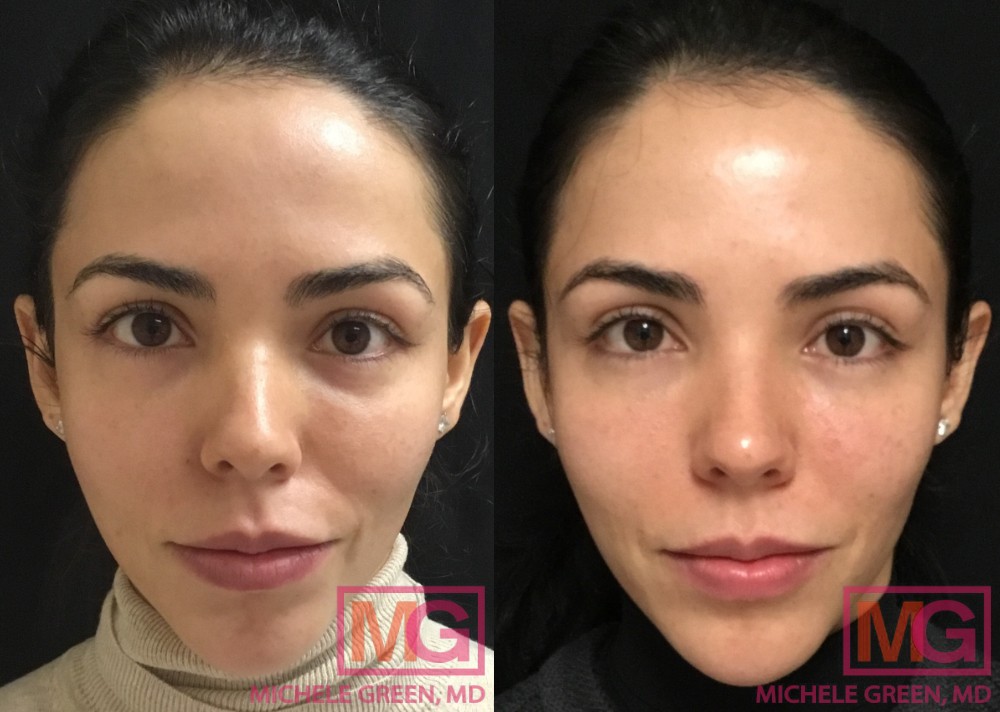
Who is a good candidate for tear trough filler?
The best candidate for dermal filler injections in the tear trough is a healthy individual with noted volume loss in the under-eye area. If there is excessive wrinkling or skin under the eyes with fat deposition, tear trough fillers may not be the best course of treatment. During your consultation with Dr. Green, she will physically evaluate your under-eye area to determine if tear trough fillers are the correct treatment for you or if another cosmetic procedure is better suited for you. If you are not a suitable candidate for tear trough fillers or other non-invasive cosmetic treatment options, Dr. Green will refer you to a trusted board-certified plastic surgeon for a surgical consultation.
What is the procedure for having under-eye dermal fillers?
The first step for having under-eye dermal fillers is to consult with Dr. Michele Green in her office on the Upper East Side of Manhattan. Dr. Green will evaluate the targeted treatment area and the skin’s elasticity, confirm you are a good candidate for tear trough fillers, and determine the appropriate dermal filler product and the number of syringes required to produce the best results. A local anesthetic will be generously applied to the entire treatment area one hour before performing any injections to ensure that the procedure is as comfortable as possible. Additionally, the dermal fillers that Dr. Green uses for the under-eye area are compounded with lidocaine, helping to guarantee that the procedure is as painless as possible. Dr. Green will inject the dermal fillers directly into the skin in tiny amounts using an ultrafine needle. While some providers prefer using a cannula, Dr. Green uses an ultrafine needle to allow for precision in the tear trough injections. Immediately upon completion of the procedure, ice will be applied to the treatment area to help prevent any swelling that may occur, and aftercare instructions will be provided. After initial treatment with dermal fillers for correction of tear troughs, Dr. Green will see you for a two-week follow-up to ensure that treatment was satisfactory and determine whether any touch-up of the hyaluronic acid dermal filler is needed.
Is tear trough filler safe?
There typically are no major side effects associated with receiving under-eye fillers. However, it is possible to develop a mild amount of swelling or bruising at or around the injection sites. Swelling and redness are common side effects at the site of injection, and icing the treated area immediately after your injections will minimize this reaction. Bruising is another potential from tear-trough fillers. To decrease bruising, Dr. Green recommends discontinuing any blood thinners as well as NSAIDs such as Advil, Aspirin, Ibuprofen, or Aleve, as these medications can worsen bruising. Additionally, patients prone to bruising can take Arnica Forte, an herbal supplement, to help prevent and heal bruises faster.
Tyndall Effect is a rare side effect that leads to the development of a bluish discoloration after some hyaluronic acid fillers are injected. The injection area can appear blue if the hyaluronic acid filler is injected too superficially. This color change can last several months in the treated area and can be reversed with hyaluronidase to dissolve the dermal filler. Some rare but more serious side effects include changes in vision, vascular occlusion signs of infection at injection sites, allergic reaction to the dermal filler product, worsening bruising or swelling, numbness, and persistent pain. In order to prevent any serious or adverse side effects from developing, it is important to have your tear trough filler injections performed by an expert, board-certified injector such as Dr. Green.
When is under-eye filler not effective?
Under-eye fillers are ineffective for treating naturally darker skin pigmentation in the under-eye area. If the appearance of dark under-eye circles is unrelated to the anatomy of the tear trough itself and is due to skin pigmentation, treating dermal fillers in the area will only emphasize the appearance of the dark circles. In these cases, Dr. Michele Green recommends The Mesopeel Periocular®, a specially formulated chemical peel designed to reduce fine lines and wrinkles, hyperpigmentation, and discoloration around the upper- and under-eye areas. Some individuals may experience excessive skin laxity in the tear troughs. Under-eye fillers are not effective for treating skin laxity and may even make the under-eye area look worse. If you suffer from excess skin underneath the eye, Dr. Green will refer you to a trusted plastic surgeon to discuss treatments better suited to your facial anatomy.
Under eye-filler versus blepharoplasty
Under-eye fillers are a non-invasive cosmetic procedure that uses dermal fillers to restore lost volume and correct hollowing in the under-eye area. Under-eye fillers are not permanent, typically lasting 6 – 9 months, and are associated with little side effects and downtime. Blepharoplasty is a type of plastic surgery that improves the appearance of the upper or lower eyelids by removing excess skin from the eyelids. It can correct excess skin, droopy eyelids, under-eye bags, puffiness, and dark circles. This surgical procedure involves making small incisions in the eyelid area and removing the excess skin. A blepharoplasty procedure is associated with long recovery times, surgical scars, and severe side effects.
Both under-eye filler and a blepharoplasty will effectively revitalize the under-eye area and result in a more youthful appearance. Tear trough filler treatment benefits those who want immediate results, don’t want any downtime, and understand that fillers are not a permanent solution. Blepharoplasty may be ideal for someone who doesn’t mind the downtime, has an excessive amount of skin laxity, has little skin elasticity, and wants permanent results. By discussing your cosmetic goals with a dermatologist like Dr. Green or a plastic surgeon, you can best determine which procedure is suited to your needs.
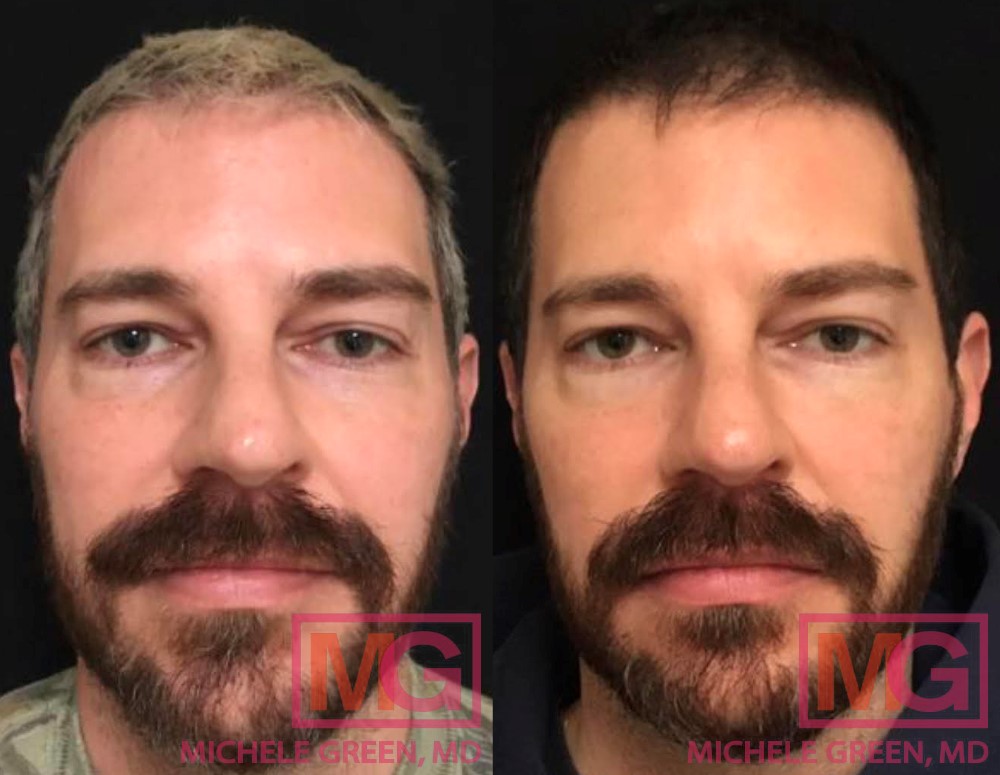
Restylane – 1 syringe, 4 weeks
Can you reverse tear trough filler treatment?
The types of fillers used to correct the appearance of eye hollows and eye bags and rejuvenate the tear trough area are composed of hyaluronic acid gel. If you are not satisfied or comfortable with your results, your injector can reverse the effects of the filler treatment using a product called hyaluronidase. Hyaluronidase injections contain the enzyme hyaluronidase, which can dissolve any unwanted facial filler product made of hyaluronic acid. Dr. Michele Green has utilized hyaluronidase to correct the appearance of nodules and poorly placed or inappropriately injected hyaluronic acid filler that patients had performed elsewhere, typically with an inexperienced injector.
What does under-eye filler do?
Under-eye filler works to correct age-related volume loss and hollowing in the tear trough area to create a natural, younger-looking appearance. The dermal fillers used to treat the tear trough area are typically composed of hyaluronic acid, a naturally occurring substance already produced by the body. Hyaluronic acid fillers are gel-like substances often used to replace lost volume and reduce lines and deep wrinkles. When injected, hyaluronic acid binds to water, softening and plumping the skin to produce a youthful appearance.
How long does tear trough filler last?
Dermal fillers typically last for anywhere from six to twelve months, depending on the exact filler used. The rate of absorption of a dermal filler varies for each patient depending on their metabolism and the location where the filler was injected. Eye rejuvenation with tear trough filler treatment can be repeated on an annual or biannual basis to maintain your desired cosmetic results.
How much is tear trough filler?
The total cost of your tear-trough filler treatment depends on several factors, such as the medical professional performing the procedure, the geographic location of the office, the type of filler used, and the amount of filler needed. Although it may be more costly to have the procedure done by a more experienced, board-certified dermatologist such as Dr. Michele Green, it is important to be very selective about your provider to ensure that unwanted side effects are avoided. Typically, fillers cost $1000 or more per syringe, depending on the exact filler. During your consultation with Dr. Green, she will assess your tear trough, cosmetic concerns, and goals to choose the best-suited dermal filler product for you. At this time, she will be able to recommend the total number of syringes needed and the cost of treatment.
How many syringes for tear trough filler?
Depending on your specific facial anatomy and aesthetic goals, 1-2 syringes of tear trough filler may be needed for complete under-eye rejuvenation. Dr. Green employs a “less-is-more” approach to dermal fillers and is extremely careful not to overfill the delicate under-eye area. When you consult with Dr. Green in her private Upper East Side dermatology office, she will determine how many syringes are needed to correct your tear troughs. Two weeks after the procedure, Dr. Green will evaluate you to determine if any touch-up of the dermal filler is needed.
Is filler under the eyes safe?
Absolutely! The FDA has approved dermal fillers for use in the midface, cheeks, nasolabial folds, nasojugal grooves, and lips. Juvederm Volbella and Restylane Eyelight are both FDA-approved for use in the under-eye area. Although the FDA has not yet approved other fillers for use in the tear trough, expert injectors commonly use dermal fillers to correct hollowing and volume loss under the eyes. The treatment is entirely safe so long as it is performed by a plastic surgeon board-certified dermatologist like Dr. Green, as it can be potentially dangerous to have tear trough filler injections done by an inexperienced or unqualified injector. By choosing to have tear trough filler treatment with an expert cosmetic injector, you will have someone with experience and knowledge of facial anatomy provide your care.
Does tear trough filler hurt?
Injections with tear trough filler should not hurt. One hour before performing under-eye filler treatment, a local anesthetic is applied to the treatment area to minimize patient discomfort. In addition, the dermal filler is compounded with lidocaine, making the process painless for the patient.
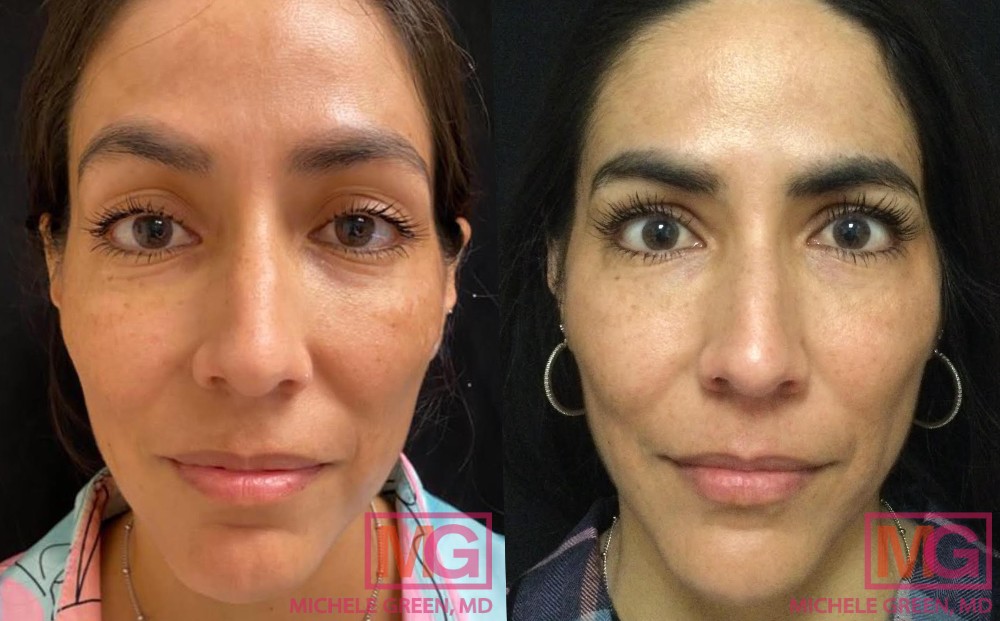
How long do under-eye fillers take to settle?
It can take up to two weeks for the under-eye filler to settle in the treatment area and for the final results to be observed. Dr. Green likes to schedule a two-week follow-up appointment for her patients with tear-trough fillers to evaluate the treatment and determine if any touch-up is required after the filler has fully settled.
Does tear trough filler migrate?
While rare, tear trough filler can migrate. Filler migration typically happens when the filler is injected too superficially or when too much filler is injected. To avoid having your tear trough filler migrate and create unwanted cosmetic results, it is essential to have your tear trough filler performed by a board-certified dermatologist such as Dr. Green, who has been performing injections for over 20 years.
Where is tear trough filler injected?
Tear trough filler should be injected by an experienced board-certified dermatologist to guarantee satisfactory cosmetic results and prevent unwanted side effects. It is injected deep into the tear troughs to smooth out the hollows that contribute to a tired-looking appearance. An expert injector such as Dr. Michele Green will perform the correct injection techniques to fill in the tear troughs while minimizing the risk of developing any adverse side effects.
What is tear trough filler?
Tear trough fillers are cosmetic injectables composed of hyaluronic acid. Whether Belotero, Restylane, Restylane Eyelight or Juvederm Volbella, the tear trough filler is injected using a thin needle into the eye area beneath the lower lid. The hyaluronic acid gel immediately adds volume to the skin and provides more moisture, restoring a youthful appearance in the treatment area. Each different family of dermal filler has slightly different properties, and no family of fillers is inherently better than the other. When you have your initial consultation with Dr. Green, she will determine the filler or combination of fillers that works best for your specific needs.
Is tear trough filler worth it?
For the right candidate, tear-trough fillers can revitalize the eye area and rejuvenate the skin. Hyaluronic acid fillers are injected into the tear troughs or the crease that goes from the tear duct to the upper cheek. While the tear trough itself is present even in youth, it can deepen as we age, creating the appearance of shadows under the eye. When the dermal filler is injected into the tear trough, it helps boost collagen production, restore lost volume, and reduce the appearance of fine lines and wrinkles. The result is a natural-looking, long-lasting, more youthful appearance.
How long does under-eye filler swelling last?
Mild swelling is a common side effect after under-eye filler injections. Typically, swelling will resolve on its own within a week of treatment, although some mild swelling may take a few weeks to resolve completely. An ice pack can be applied immediately after the procedure to mitigate any localized swelling. Patients should also avoid excessive heat, such as saunas or hot tubs, for 48 hours after treatment to minimize any risk of swelling.
How long does under-eye filler bruising last?
Bruising is another common side effect from under-eye fillers that can typically resolve within one week following the procedure. Dr. Green recommends ceasing any blood thinning medications for two weeks before your under-eye filler treatment, as both blood thinners and herbal supplements may increase the chances of developing bruising in the injected area. Patients prone to bruising can start taking Arnika Forte, an herbal supplement, a few days before the procedure to prevent bruising and accelerate the healing rate.
What age should you get a tear-trough filler?
Tear trough fillers are an appropriate treatment option for anyone with noticeable hollows in the undereye area. Patients treated with tear trough fillers are typically between the ages of 20 and 60. The best way to determine whether you are a candidate for tear-trough filler treatment is by consulting with an expert in cosmetic dermatology, such as Dr. Michele Green in New York City. Dr. Green has over two and a half decades of experience providing her patients worldwide with the best non-invasive treatment options available, including tear trough filler. She will work with you to develop a customized treatment plan for rejuvenation that best addresses your concerns and achieves your ideal aesthetic results.
Which complementary treatments can be performed with tear trough fillers for facial rejuvenation?
Botox is one of the most popular cosmetic treatments in the United States because of its outstanding ability to soften the appearance of fine lines and wrinkles, including around the eyes. Botox is popularly used to treat the outer canthal lines (crow’s feet) that appear as a result of smiling, squinting, and other repeated expressive movements. Botox injections into the orbicularis-oculi muscle, or the ring-shaped muscle surrounding the eye, work to relax the muscle, soften the appearance of wrinkles, and prevent the formation of fine lines! Dr. Green often treats patients for tear troughs and crow’s feet in the same visit, using dermal filler and Botox to achieve total rejuvenation of the eye area.
Under-eye dark circles and wrinkles can be improved through Microneedling. Microneedling® uses a tool with tiny surgical-grade needles embedded in the tip to create microscopic wounds on the surface layer of the skin (the epidermis). Through the natural wound-healing process of the skin, these micro-injuries are repaired as new, healthier skin cells grow, and new collagen and elastin are produced. This helps to plump and firm skin, diminish signs of aging, and minimize the overall appearance of dark circles.
The effects of Microneedling can be further enhanced by combining the treatment with platelet-rich plasma (PRP). PRP employs the cytokines and growth factors in plasma derived from a sample of the patient’s blood to boost the effects of microneedling. The solution penetrates the skin more readily through the newly created micro-channels made by microneedles, helping to speed up the healing process and promote even more regeneration at the cellular level to rejuvenate your skin.
Thermage is the gold standard in facial skin tightening. Thermage can improve skin elasticity in many body areas, including the delicate under-eye area. Thermage uses radiofrequency energy to stimulate collagen production in the skin. Thermage can produce skin-tightening results that last up to two years in a single treatment. Most patients, however, choose to engage in annual maintenance treatment sessions to keep up the best results. There is zero downtime involved with Thermage, meaning patients can resume their normal daily activities immediately after the procedure and easily schedule their treatment sessions.
A chemical peel can revitalize baggy or sagging skin under the eyes by removing dead skin cells along the superficial top layer of the skin. This then allows healthy new skin cells to be exposed, which can help make the skin firmer and reduce fine lines, discoloration, pigment, and other visible signs of aging on the skin. Dr. Green uses custom formulations for her chemical peels to incorporate the best nourishing serums and skin care treatments for each patient.
Non-ablative laser resurfacing treatments, such as Fraxel and eMatrix, can be used to tighten and firm, wrinkly skin under the eyes, as well as diminish the appearance of pigment discoloration in the eye area. The amount of collagen production that laser resurfacing activates can lead to lasting improvement in under-eye bags with virtually no recovery time. The eMatrix laser was developed with a special tip to treat the delicate under-eye area. Through radiofrequency technology, the eMatrix can tighten the skin around the delicate under-eye, remove fine lines, decrease pigmentation, and increase collagen production.
To determine which combination of cosmetic treatments is most appropriate for you, it’s best to first have a consultation with a board-certified expert in dermatology, like Dr. Michele Green. Dr. Green takes a holistic approach to customize each of her patient’s treatment plans to achieve the best results without the need for cosmetic surgery. During a consultation, your medical history will be discussed in depth, and an individualized plan will be established to address your unique skin concerns.
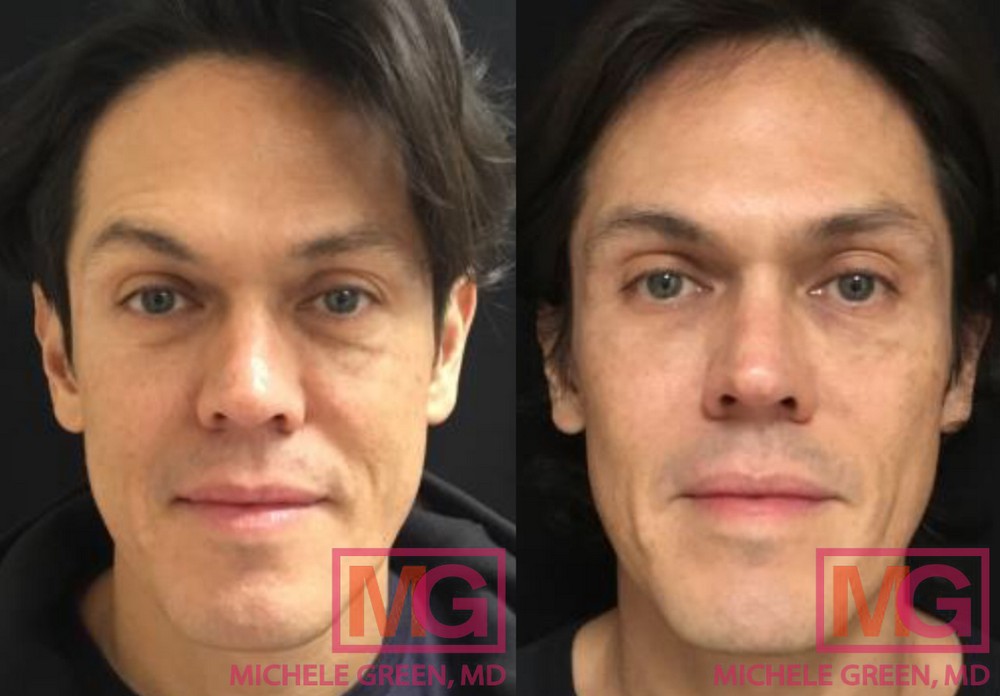
How do I get started with tear trough fillers today?
Tear trough fillers are a non-invasive cosmetic procedure designed for the rejuvenation of the under-eye area. A tear trough is a crease in the under-eye area that looks sunken in, causing a tired, worn-out appearance and often worsening over time with age. Tear trough filler injections are placed between the lower eyelid and upper cheek to replenish volume and smooth out the under-eye hollows that can cast a shadow and result in the appearance of dark circles. If you’re looking for a solution for tired-looking under-eyes that doesn’t involve plastic surgery, significant downtime, or side effects, Dr. Green in NYC is here to help.
Dr. Michele Green is an internationally renowned board-certified cosmetic dermatologist and expert injector. With over 25 years of experience with tear trough fillers, Botox, chemical peels, Thermage®, and Fraxel® lasers, Dr. Green will work with you to develop a personalized treatment plan for under-eye rejuvenation that best suits your needs and goals. Dr. Green is consistently voted as one of the best dermatologists in New York by Castle Connolly, New York Magazine, Super Doctors, and the New York Times for her dedication to her patients and expertise, and she is here to help you restore a more youthful appearance and minimize dark under eye circles, puffiness, and under eye bags. Please contact us online today or call 212-535-3088 to find out how to get started with tear trough fillers today.
 212-535-3088
212-535-3088